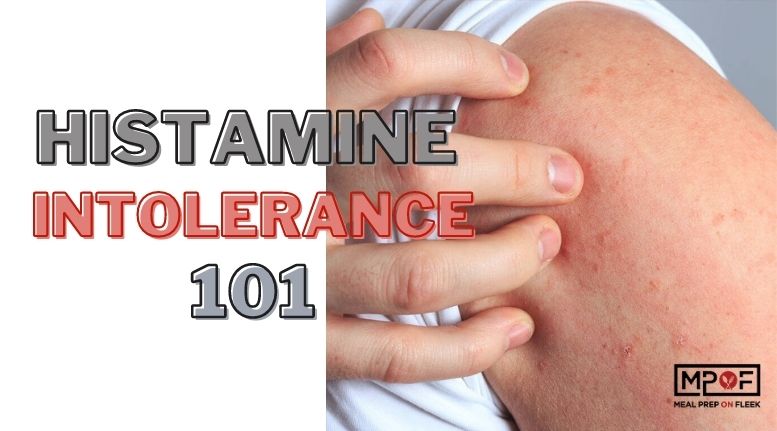Histamine Intolerance 101
What is histamine?
Histamine is a naturally occurring chemical in the body whose main role is to help your body get rid of allergens. It also plays an essential role in the body’s inflammatory response and defense system, functions as a neurotransmitter (brain chemical messenger) and plays an important part in gut health. When histamine is released, it causes inflammation to alert the body of potential pathogens, allergens, etc. so white blood cells can accumulate in the affected area for healing. We also need histamine in order to digest food, move our bowels, boost exercise performance, increase attention, and get blood as well as nutrients and oxygen delivered to different parts of the body.
What is histamine intolerance?
When this pathway occurs as it is designed to, the body releases histamine, then as the pathogens are taken care of by the immune system, our histamine and inflammation levels go back down to homeostasis. The problem occurs when the body doesn’t have the capability to break down an elevated amount of histamine, and it begins to build up in the body. When your histamine levels increase, your tolerance to histamine triggers decreases. When histamine levels in the body stay high for an extended amount of time because the body cannot break down the histamine, this can result in histamine intolerance. Unlike a food sensitivity, histamine intolerance means that too much of the chemical has built up in the body, and/or the body cannot break it down properly. At this point, histamine can cause a wide variety of symptoms, and these symptoms can vary depending on where it is released in the body.
In a healthy body, histamine is broken down within the body by the enzymes DAO (diamine oxidase - in the digestive system) and HNMT (histamine N-methyltransferase - in the spine, kidneys, liver, lungs, etc.). With histamine intolerance, there could either be a genetic or a simple impairment in either or both of the enzymes responsible for the histamine breakdown leading - to histamine build-up and a cascade of other unwanted symptoms.
Histamine receptors are all over the body, in the immune system, the stomach, the brain, and the bone marrow and white blood cells - so histamine intolerance presents in a multitude of allergy-related responses and symptoms, like:
- Congestion or runny nose
- Headaches or migraines
- Hives
- Flushing
- Fatigue
- Anxiety
- Eczema/psoriasis
- Edema or tissue swelling
- Digestive issues
- Abnormal menstrual cycle
- Irregular heartbeat (tachycardia)
- Dizziness or vertigo
What causes high histamine levels?
Histamine levels increase in the body resulting from high histamine or histamine liberating foods in the diet, consuming alcohol or caffeine, hormonal imbalances, or nutritional deficiencies. Allergies and allergic reactions can also contribute to a release of more histamine (and high histamine levels contribute to even more allergy-type symptoms.) Environmental factors like exposure to allergens, toxic home and personal care products, mercury amalgams, exposure to smoke or mold, can also trigger a histamine response. Having high histamine levels in the body is similar to being in a chronic inflammatory state, which is why many people with histamine intolerance feel like their symptoms exponentially get worse if left unchecked.
Stress is also a major trigger for histamine in the body. Every time cortisol is released in response to stress, the sympathetic (fight-or-flight) branch of the nervous system is activated, increasing mast cells - which leads to histamine being released into the bloodstream. While histamine is an inflammatory agent, and cortisol is an anti-inflammatory agent produced in response to inflammation, the adrenals now start to work in overdrive to produce more cortisol, leading back to the beginning of this vicious cycle.
What can cause histamine intolerance?
While these factors cause the release of histamine in the body and a lack of DAO and HMNT can contribute to the buildup of histamine, there is always a deeper cause at the root of histamine intolerance that cannot be treated with diet, supplements, and stress management alone.
Some of the most common root causes of histamine intolerance:
- Gut dysbiosis & intestinal permeability
- Gut infections (SIBO, H.Pylori, Candida, parasites, etc.)
- Mast cell activation syndrome
- Genetic mutations
- Certain medications that interfere with the production of DAO or HNMT (antiacids, antibiotics, and antihistamines can inhibit DAO enzyme activity, and increase histamine production)
- Gluten intolerance or celiac disease
- Inflammatory Digestive Disease (Crohn's, colitis, celiac)
So what can you do about it?
If you suspect you may have histamine intolerance, it’s necessary to work with a qualified practitioner who can help you do some testing to get to the root of where your symptoms are coming from and help you get them under control with a targeted protocol. Histamine intolerance and mast cell activation syndrome are extremely complicated and have many more factors at play than could be covered in the scope of this article. To learn more about a low histamine diet protocol that may help manage your symptoms in addition to your work with a qualified healthcare practitioner, click here.
More histamine intolerance resources:
The 4-Phase Histamine Reset, Dr. Becky Campbell
Dr. Becky Campbell - Histamine Intolerance Specialist
Dr. Amy Burkhart - Histamine Intolerance
Dr. Beth O’Hara - Mast Cell 360
Dana Monsees, MS, CNS, LDN
Maintz L, Novak N. Histamine and histamine intolerance. Am J Clin Nutr 2007;85(5):1185-1196. [Full Text]







